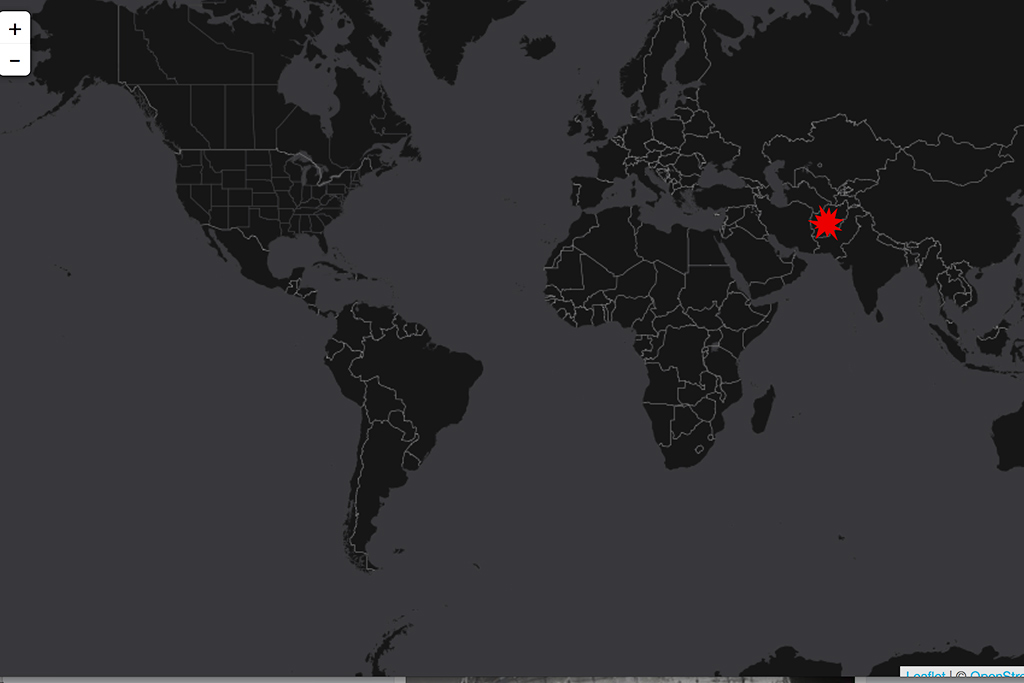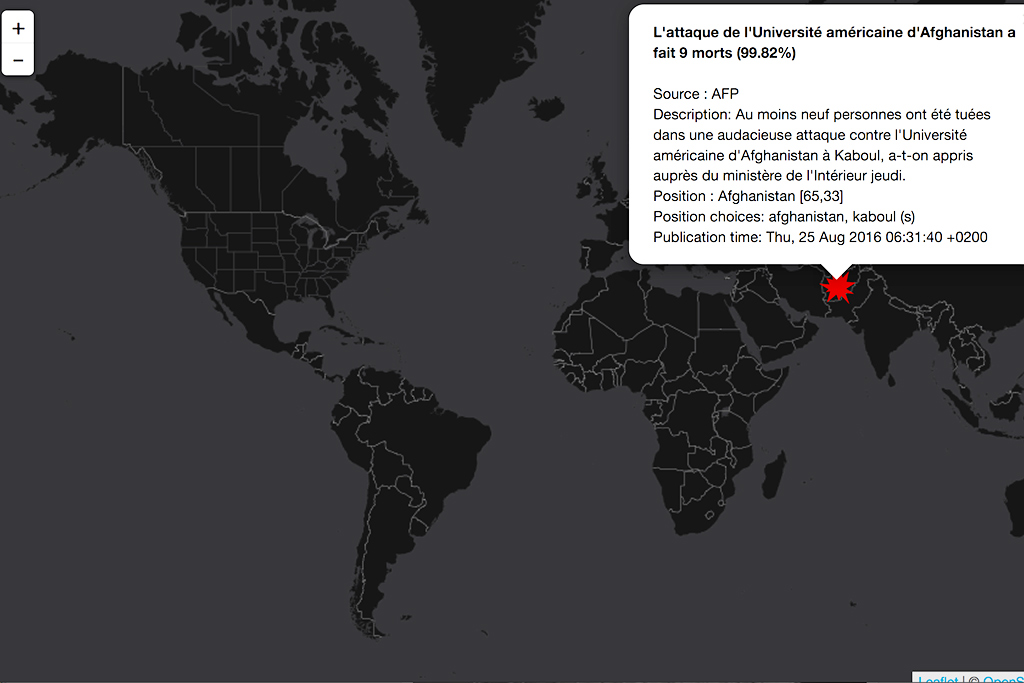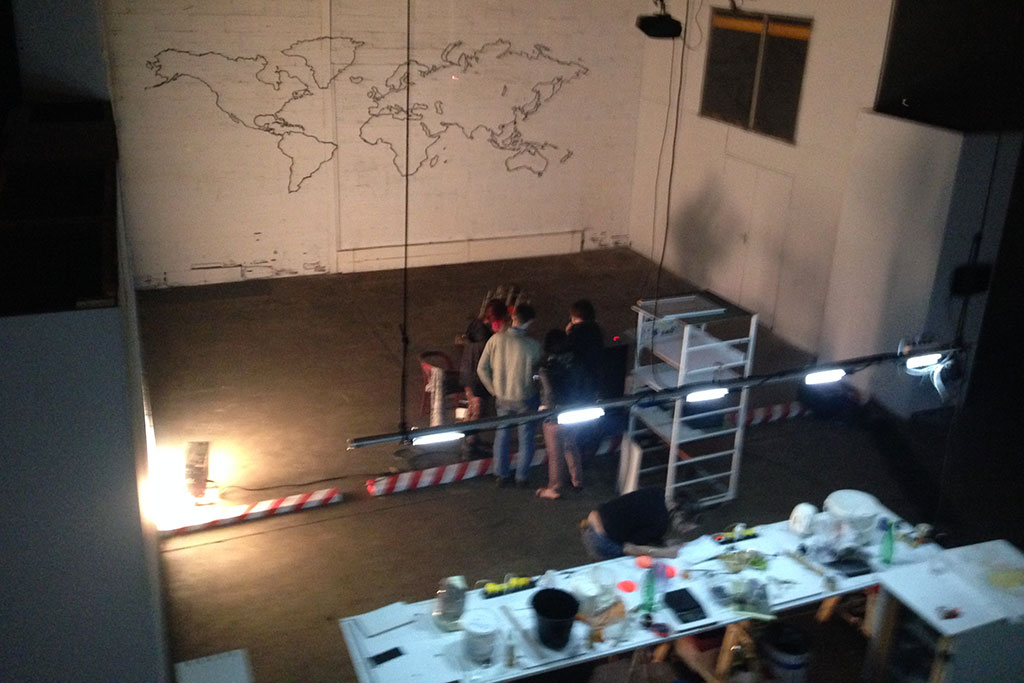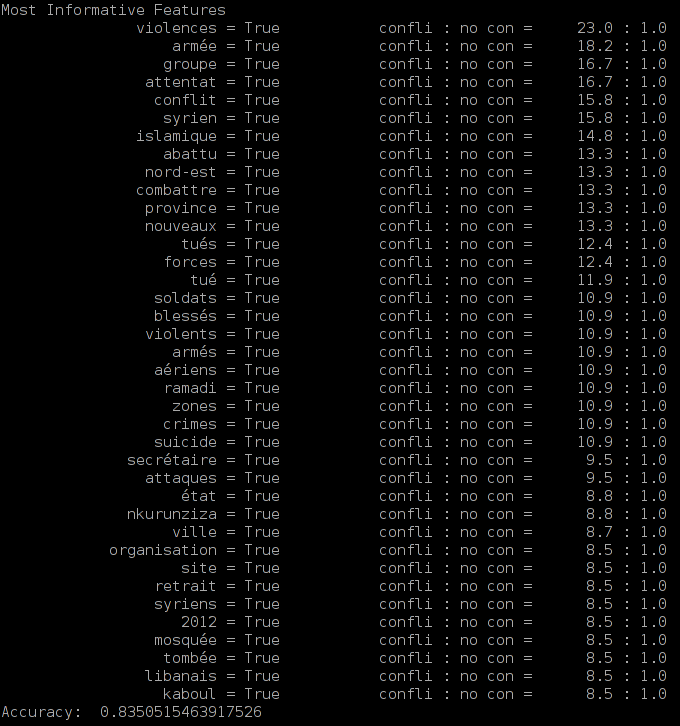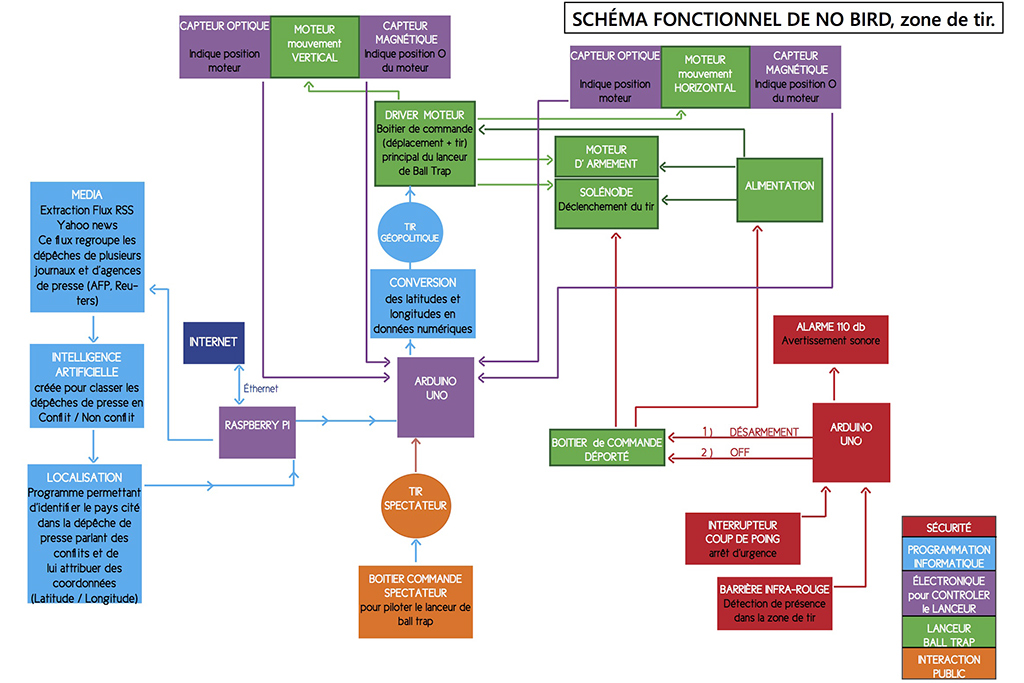Interactive installation, variable dimensions, 2014 – 2017.
Computer realisation: Vross.
Electronic realisation: Gregory Bayarri, Zamplin, Philippe Martorell.
Produced with the support of Snootlab, Laporte entreprise, THSF #7 & Oudeis.
Support from the DRAC in 2014, as part of individual creation aid.
At the crossroads of installation, workshop, engineering and a DIY aesthetic, No Bird integrates a ball-trap mechanism, a propeller of trays made of papier-mâché, all connected to a computer system listing and analyzing in real time RSS feeds whose subjects relate to geopolitical conflicts in order to observe and show the conflicts most represented in the media.
Do media focuses on certain conflicts shape public opinion, its ideals and a certain understanding of the world?
No Bird is divided into two spaces:
-a DIY production workshop including all the equipment necessary to modify ball trap boards from your newspapers.
– a shooting zone containing a controlled trap ball launcher:
– or by press reports extracted from the yahoo news RSS feed.
– or by visitors via a control box. (alpha version)
No Bird explodes information, defeats the automation of data and the abstraction of territories through a reappropriation of the tools of power.
No Bird becomes a geopolitical, strategic, poetic tool and reveals through the space in which it is activated the need for critical thinking about the media and the urgency of a deconstruction of informational mechanics, themselves vectors of a power.
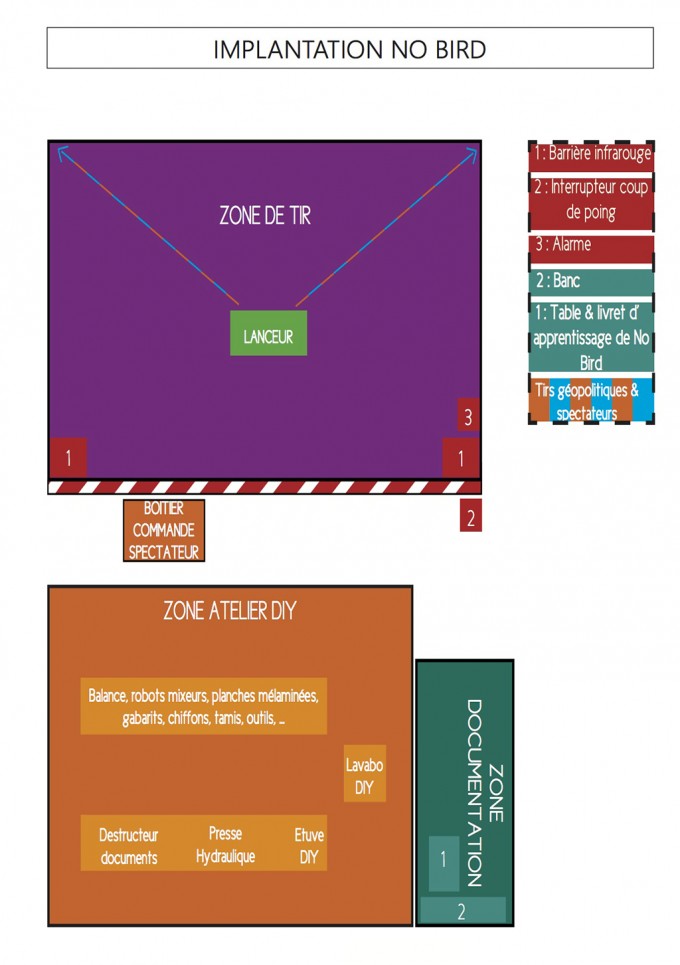
DIY workshop for the production of modified trap shooting boards:
Document shredder, scales, mixers, templates, rags, sieves, water jerrycan, basins, boards, rollers, flour, paper glue, neon lights, trestles, newspapers.
Oven, sink and DIY hydraulic press.
The workshop is largely made up of objects created using techniques taken from the web, in a DIY logic and offers visitors the opportunity to make paper pulp from newspapers they have brought.
The workshop is located opposite the planisphere targeted by the ball-trap thrower. It is arranged in a friendly and practical way to allow several people to create at the same time, by exchanging with their neighbor, or by following the tutorials at their disposal.
Each participant shreds the newspaper brought using the document shredder.
Then he mixes the pieces of newspaper with water to have a homogeneous consistency.
Finally, he drains everything in a cloth in order to extract as much water as possible until he obtains a paper paste which he will use to modify the ball trap boards.
The tools necessary for this achievement are freely accessible and can be used for self-management: from using the tool to cleaning it.
By offering this deliberately low-tech interaction time, I invite participants to question the production of information and the perception of the world induced by this continuous media flow.
Documentation area: No Bird computer program learning workbook (Supervised machine learning program applied to text, so that the algorithm learns to classify new data based on what it knows: a set of data classified manually), table, bench.
Each week the computer program gives us the 100 most representative/characteristic words from dispatches concerning a conflict. These « most informative features » are classified according to the news and made available to the public during the exhibition
Shooting zone: Ball-trap launcher, laser, optical sensors, arduino, raspberry pi, ethernet, infrared barrier + punch switch connected to an alarm, planks, control box controlled by the public, ball-trap targets.
The shooting zone is demarcated by planks placed on the ground, painted red and white.
A trap thrower is stationed in the middle of the area, loaded with orange targets, ready to receive the GPS coordinates of the countries in conflict cited by the media and to aim them or to be directed by visitors.
The ground is littered with hundreds of small pieces of broken orange and black trays.
On the wall, a planisphere is drawn facing the launcher.
Each shot from the launcher generates a trace.
Over the course of geopolitical news, the material accumulates shaping colored protuberances in places, hollows, solids… a bas-relief emerges and forms a topographical landscape resulting from the treatment of conflicts by the media mixed with the action of the spectators.
In order to be able to control the trap launcher at our convenience, its control box is modified: an Arduino card is connected in place of the PIC microcontroller, thanks to the reverse engineering skills of Gregory Bayarri
Geopolitical shot:
– The yahoo news RSS FEED is extracted from the internet via a raspberry pi to retrieve press articles, every hour.
Yahoo news brings together press agencies (AFP, Reuters) and around ten different newspapers (from Figaro to Libération).
– CLASSIFICATION: the computer program processes and classifies press dispatches into two groups: Conflict and Non-conflict.
This program has a memory made up of dispatches analyzed and classified beforehand manually. This allows him to identify the vocabulary used by the press to talk about conflicts. He can thus classify the dispatches into the appropriate group by probability. The more the program is confronted with different data and contexts, the more the reliability of these choices increases.
– LOCALIZATION: After having carried out its classification, the program searches for the names of the countries cited in the dispatches classified as Conflict. Then he associates each of his dispatches with a geographical position, namely the coordinates (latitude-longitude) of the center of the countries, more representative for us than the coordinates of the capital.
This information is sent by the Raspberry to the Arduino so that it directs the balltrap launcher.
This also allows you to create a map to visualize conflict zones.
– CONVERSION: The Arduino card recovers the GPS coordinates and converts them into digital data to control the ball-trap board and trigger the shot.
Technologies used for news analysis:
– NLTK: for supervised learning
– Feedparser: for data retrieval via RSS feed
– BeautifulSoup4: to separate the HTML code from the useful information
– Urllib3: to send HTTP requests
– Geojson: to parse and save files in GeoJSON format
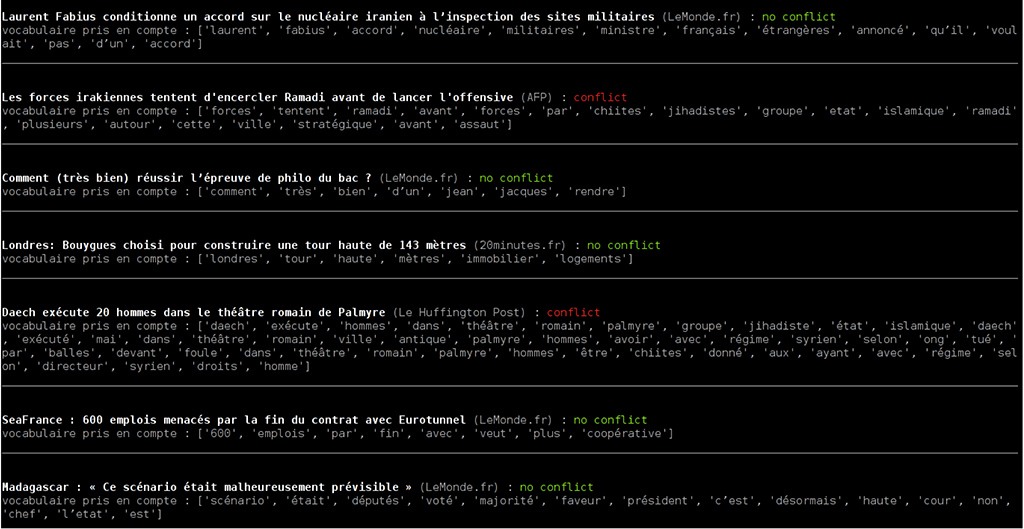
Copie d’écran du programme de classification.
Visitor shooting: In the alpha version the visitor has the possibility to take a position and choose a type of action in the face of this conflicting news, via a control box: do not shoot, shoot at the country he thinks is responsible, shoot in the margins of the planisphere. The Utopian Space command offering the possibility of deliberately non-violent interaction is not yet programmed, … The relevance of the visitor shot is currently being questioned.
WORK IN PROGRESS
This project began on paper in mid-2014 and materially in mid-2015, it evolved through questions, meetings, failures and resolutions of problems encountered at different stages of its construction until it could be presented in a version Alpha during the Toulouse Hacker Space Factory in May 2016.
Different aspects of the project are still under development, modification, reflection.
